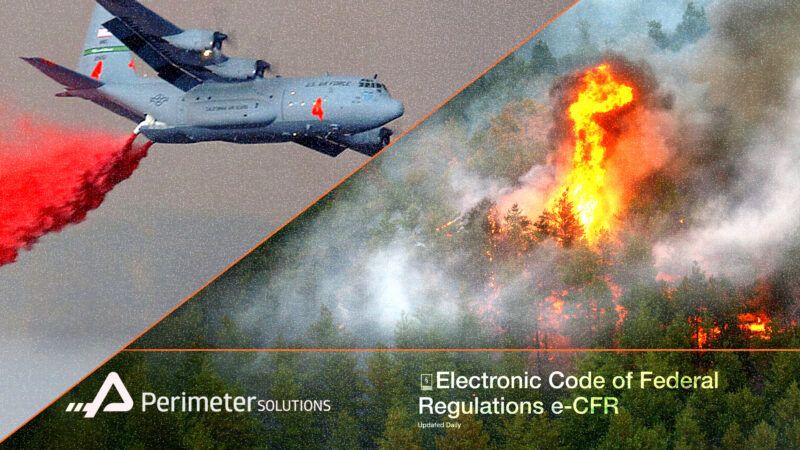How Overregulation Burned Out Competition in the Fire Retardant Industry
Companies chose to exit the market rather than deal with the excessive regulations baked into the industry.

Government regulations stifle competition across multiple sectors of the economy, protecting incumbents and making it hard for new companies to emerge. While this is well-documented in areas such as health care and baby formula, it is also present in a niche yet vital industry: fire retardant.
"Fire retardant, the reddish liquid dropped from planes to slow spreading flames, has become an indispensable tool for saving lives and property from more frequent and intense wildfires," The New York Times reported on Wednesday. "But the entire supply of the product in the United States is controlled by a single company." That company is Perimeter Solutions.
Perimeter is the exclusive long-term fire retardant (LTFR) provider to the U.S. Forest Service—a position it has held since 2005—and is currently under a contract that grants it sole supply rights. For years, the federal government has sought to diversify its supply of LTFR. A 2022 memo from the Agriculture Department described this sole-source relationship as a "massive risk," and a 2023 Government Accountability Office (GAO) report also flagged agencies' reliance on a single approved manufacturer.
Since 2018, the Forest Service has taken steps to encourage potential competitors in the industry, to no avail. Competing in the fire retardant industry is difficult due to high start-up costs and complex regulations.
To receive approval from regulators, companies must test their products to demonstrate compliance with various complex environmental laws. The applicant bears all costs for tests and retests. Regulators can require additional testing if products "trigger concern," potentially delaying or complicating the development of these products.
Products also undergo field evaluations that include firefighting operations under varying conditions for several months. Potential competitors, such as Fortress Fire Retardant Systems, faced over a year of lab and field testing to gain entry onto the Forest Service's Qualified Products List (QPL), which would enable them to sell their products not only to the U.S. government but also to other fire management organizations worldwide.
After Fortress finally received federal approval in 2022, Perimeter ratcheted up pressure against its new rival. The company launched a website, which claimed magnesium chloride, the key ingredient in Fortress's retardant, should "only be used to clear ice off highways and not dropped from airplanes to protect you or your home from wildfire."
Perimeter's then-chief executive Edward Goldberg also wrote a magazine feature, and the company formed the United Aerial Firefighting Association (UAFA) to lobby federal officials against Fortress by raising concerns about alleged safety issues with its product. Interestingly, a 2025 LAist.com investigation revealed Perimeter's fire retardant contains harmful heavy metals like "lead, arsenic, cadmium and chromium," which Perimeter failed to disclose in public safety documents.
Perimeter's efforts paid off, and in 2024, the Forest Service revoked Fortress' permit. However, in January, Fortress was awarded a $13 million deal by the Forest Service to supply testing materials. Perimeter then filed a protest against Fortress' deal, claiming that the agency failed to consider it as an alternative and that the sole-source contract awarded to Fortress created an unfair competitive advantage.
Though Fortress survived the initial public relations campaign against it, Compass Minerals, the company that owns Fortress, shuttered the fire-retardant arm of its company to "improve the profitability," as it could no longer afford the fight.
Its work consolidating the market has resulted in a significant boost to Perimeter's bottom line; the company's stock price increased by 6.83 percent in the first quarter of 2025. In January, as California's firefighting agency sought to protect Los Angeles from the wildfires ravaging the city, the LTFR used costs "20 to 30 percent more than it did four years ago, substantially outpacing inflation," according to The New York Times.
The Times also found that the U.S. government spent double the amount on fire retardant between 2021 and 2024, resulting in over $250 million paid to Perimeter in the latter year. Already in 2025, the company has signed federal contracts with the Forest Service totalling $166 million.
It's easy to frame Perimeter's success as a monopoly acting in an unfavorable way to crush competition in the market.
Still, excessive licensing regulations and poor management of federal lands—which have made wildfires more damaging and expensive, boosting Perimeter's bottom line—have arguably played a larger role in entrenching Perimeter's place in the industry than sharp or unethical conduct.
